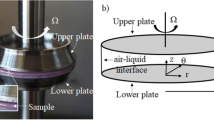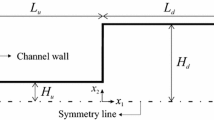Abstract
In this paper, we modify the thermodynamically compatible third-grade fluid model by introducing a shear-rate- and volume-fraction-dependent viscosity into the equation. With this new model, it is possible to predict not only the normal stress differences, but also the variable viscosity observed in many suspensions. We study the Couette–Poiseuille flow of such a fluid between two horizontal flat plates. The steady fully developed flow equations are made dimensionless and are solved numerically; the effects of different dimensionless numbers are discussed.





Similar content being viewed by others
Notes
Morgan [29] suggested that in general, an implicit constitutive equation is a relation between a kinetic tensor (for example the stress tensor T) and one kinematic tensor (for example B, or D) of the types [see Eqs. (3.5) and (3.6) of that paper]: \(\mathbf{G(T,B)}=\mathbf{0};\;\mathbf{H(T,D)}=\mathbf{0}\).
Criminale et al. [3] obtained an expression for T, valid for any laminar shear flow:
$$\begin{aligned} \mathbf{T}=-p\mathbf{I}+\beta _1 \mathbf{A}_\mathbf{1} +\beta _2 \mathbf{A}_\mathbf{2} +\beta _3 \left( {\mathbf{A}_\mathbf{1}^\mathbf{2} +\frac{1}{2}\mathbf{A}_\mathbf{2} } \right) ;\qquad \qquad \qquad \qquad (*) \end{aligned}$$where \(\beta _{1}\), \(\beta _{2}\) and \(\beta _{3}\) are functions of \(\Pi \), where \(\Pi =\frac{1}{2}\mathrm{tr} \mathbf{A}_1^2 \) , and they are given by
$$\begin{aligned} \beta _1= & {} \gamma _1 +2\gamma _5 \Pi +4\gamma _7 \Pi ^{2},\\ \beta _2= & {} \gamma _2 +0.5\gamma _3 +2\left( {\gamma _4 +\gamma _6 } \right) +4\gamma _8 \Pi ^{2},\\ \beta _3= & {} \gamma _3 ,\\ \gamma _m= & {} \alpha _m \left( {2\Pi , 0, 4\Pi ^{2}, 8\Pi ^{3},\;0,\;2\Pi ^{2}, 0, 4\Pi ^{4}} \right) , \end{aligned}$$The model given by Eq. (*) is known as CEF model. It can be seen that when \(\beta _{2}\) = 2\(\beta _{3}\), this equation reduces to the Reiner–Rivlin fluid model [38, 39]. Now, since \(\beta _{1}\), \(\beta _{2}\) and \(\beta _{3}\) can be assigned arbitrarily as function of \(\Pi \), in theory, the CEF model can predict shear-thinning (or thickening) as well as normal stress effects.
Note that the simplest expression for the nonlinear behavior of fluids is that of the generalized power-law model where \(\mathbf{T}=-p\mathbf{I}+\mu _0 \left( {\mathrm{tr}\mathbf{A}_\mathbf{1}^\mathbf{2} } \right) ^{m}\mathbf{A}_\mathbf{1} \) when \(m < 0\), the fluid is shear thinning, and if \(m > 0\), the fluid is shear thickening. This equation is a subclass of the model presented here.
Abbreviations
- b :
-
Body force vector
- D :
-
Symmetric part of the velocity gradient
- g :
-
Acceleration due to gravity
- H :
-
Characteristic length
- l :
-
Identity tensor
- L :
-
Gradient of the velocity vector
- t :
-
Time
- T :
-
Cauchy’s stress tensor
- U :
-
Reference velocity
- x :
-
Spatial position occupied at time t
- y :
-
Direction normal to the inclined plane
- (Y) or \(\overline{y} \) :
-
Dimensionless y
- \(\phi \) :
-
Volume fraction
- div:
-
Divergence operator
- \(\nabla \) :
-
Gradient symbol
References
Barnes, H.A., Hutton, J.F., Walters, K.: An Introduction to Rheology. Elsevier, Amsterdam (1989)
Bird, R.B., Armstrong, R.C., Hassager, J.: Dynamics of Polymeric Liquids, vol. 1. Wiley, New York (1977)
Criminale, W.O., Ericksen, J.L., Filbey, G.L.: Steady shear flow of non-Newtonian fluids. Arch. Ration. Mech. Anal. 1, 410–417 (1958)
Dunn, J.E., Fosdick, R.L.: Thermodynamics, stability, and boundedness of fluids of complexity 2 and fluids of second grade. Arch. Ration. Mech. Anal. 56, 191–252 (1974)
Dunn, J.E., Rajagopal, K.R.: Fluids of differential type: critical review and thermodynamic analysis. Int. J. Eng. Sci. 33, 689–729 (1995)
Ekmann, J.M., Wildman, D.J., Chen, J.L.S.: Laminar flow studies of highly loaded suspensions in horizontal pipes. In: Second International Symposium on Slurry Flows ASME FED, vol. 38, pp. 85 (1986)
Fosdick, R.L., Rajagopal, K.R.: Thermodynamics and stability of fluids of third grade. Proc. R. Soc. Lond. A 339, 351–377 (1980)
Govier, G.W., Aziz, K.: The Flow of Complex Mixtures in Pipes. Krieger Publishing Company, Malabar (1972)
Gupta, G., Massoudi, M.: Flow of a generalized second grade fluid between heated plates. Acta Mech. 99, 21–33 (1993)
Happel, V., Brenner, H.: Low Reynolds Number Hydrodynamics. Prentice Hall, Upper Saddle River (1965)
Kabir, M.A., Jasti, V.K., Higgs III, C.F., Lovell, M.R.: An evaluation of the explicit finite-element method approach for modelling dense flows of discrete grains in a Couette shear cell. Proc. IMechE Part J J. Eng. Tribol. 222, 715–720 (2008)
Larson, R.G.: The Structure and Rheology of Complex Fluids. Oxford University Press, New York (1999)
Liu, I.S.: Continuum Mechanics. Springer, Berlin (2002)
Macosko, C.W.: Rheology: Principles, Measurements and Applications. Wiley, New York (1994)
Man, C.-S., Massoudi, M.: On the thermodynamics of some generalized second-grade fluids. Contin. Mech. Thermodyn. 22, 27–46 (2010)
Man, C.S.: Nonsteady channel flow of ice as a modified second-order fluid with power-law viscosity. Arch. Ration. Mech. Anal. 119, 35–57 (1992)
Man, C.S., Sun, Q.K.: On the significant of normal stress effects in the flow of glaciers. J. Glaciol. 33, 268 (1987)
Mansutti, D., Rajagopal, K.R.: Flow of a shear thinning fluid between intersecting planes. Int. J. Non-Linear Mech. 26, 769–775 (1991)
Mansutti, D., Pontrelli, G., Rajagopal, K.R.: Non-similar flow of a non-Newtonian fluid past a wedge. Int. J. Eng. Sci. 31, 637–647 (1993)
Marcus, R.D., Leung, L.S., Klinzing, G.E., Rizk, F.: Pneumatic Conveying of Solids. Chapman and Hall, London (1990)
Massoudi, M.: On the flow of granular materials with variable material properties. Int. J. Nonlinear Mech. 36, 25–37 (2001)
Massoudi, M.: A note on the meaning of mixture viscosity using the classical continuum theories of mixtures. Int. J. Eng. Sci. 46, 677–689 (2008)
Massoudi, M.: A mixture theory formulation for hydraulic or pneumatic transport of solid particles. Int. J. Eng. Sci. 48, 1440–1461 (2010)
Massoudi, M., Vaidya, A.: On some generalizations of the second grade fluid model. Nonlinear Anal. Part II Real World Appl. 9, 1169–1183 (2008)
Massoudi, M., Phuoc, T.X.: Fully developed flow of a modified second grade fluid with temperature dependent viscosity. Acta Mech. 150, 23–37 (2001)
Massoudi, M., Phuoc, T.X.: Flow of a generalized second grade non-Newtonian fluid with variable viscosity. Contin. Mech. Thermodyn. 16, 529–538 (2004)
Massoudi, M., Christie, I.: Effects of variable viscosity and viscous dissipation on the flow of a third grade fluid. Int. J. Non-Linear Mech. 30, 687–699 (1995)
Massoudi, M., Sanchez, G., Vaidya, A.: An engineering approach to pipeline transport of biomass. Bull. N. J. Acad. Sci. 57, 9–11 (2012)
Morgan, A.J.A.: Some properties of media by constitutive equations in implicit form. Int. J. Eng. Sci. 4, 155–178 (1966)
Oldroyd, J.G.: On the formulation of rheological equations of state. Proc. R. Soc. Lond. A200, 523–541 (1950)
Oldroyd, J.G.: An approach to non-Newtonian fluid-mechanics. J. Non-Newton. Fluid Mech. 14, 9–46 (1984)
Papachristodoulou, G., Trass, O.: Coal slurry fuel technology. Can. J. Chem. Eng. 65, 177 (1987)
Phillips, R.J., Armstrong, R.C., Brown, R.A., Graham, A.L., Abbott, J.R.: A constitutive equation for concentrated suspensions that accounts for shear-induced particle migration. Phys. Fluids A 4, 30–40 (1992)
Rajagopal, K.R.: On implicit constitutive theories for fluids. J. Fluid Mech. 550, 243–249 (2006)
Rajagopal, K.R.: A note on unsteady unidirectional flows of a non-Newtonian fluid. Int. J. Non-Linear Mech. 17, 369–373 (1982)
Rajagopal, K.R.: On boundary conditions for fluids of differential type. In: Sequeira, A. (ed.) Navier–Stokes Equations and Related Nonlinear Problems, pp. 273–278. Plenum Press, New York (1995)
Rajagopal, K.R., Kaloni, P.N.: Some remarks on boundary conditions for flows of fluids of the differential type. In: Graham, G.A.C., Malik, S.K. (eds.) Continuum Mechanics and its Applications. Hemisphere Press, pp. 935–942 (1989)
Reiner, M.: A mathematical theory of dilatancy. Am. J. Math. 67, 350–362 (1945)
Rivlin, R.S.: The hydrodynamics of non-Newtonian fluids. I. Proc. R. Soc. Lond. 193, 260–281 (1948)
Rivlin, R.S., Ericksen, J.L.: Stress deformation relations for isotropic materials. J. Ration. Mech. Anal. 4, 323–425 (1955)
Roh, N.S., Shin, D.Y., Kim, D.C., Kim, J.D.: Rheological behavior of coal–water mixtures: 1. Effects of coal type, loading and particle size. Fuel 74, 1220 (1995)
Schlichting, H.: Boundary Layer Theory, 7th edn. McGraw-Hill, New York (1979)
Schowalter, E.R.: Mechanics of Non-Newtonian Fluids. Pergamon Press, New York (1978)
Shook, C.A., Roco, M.C.: Slurry Flow: Principles and Practices. Butterworth-Heinemann, Boston (1991)
Slattery, J.C.: Advanced Transport Phenomena. Cambridge University Press, Cambridge (1999)
Soo, S.L.: Particulates and Continuum: Multiphase Fluid Dynamics. Hemisphere Publishing House, New York (1989)
Truesdell, C.: The mechanical foundations of elasticity and fluid dynamics. J. Ration. Mech. Anal. 2, 593–616 (1953)
Truesdell, C.: Hypo-elasticity. J. Ration. Mech. Anal. 4, 83–131 (1955)
Truesdell, C., Noll, W.: The Non-Linear Field Theories of Mechanics. Springer, New York (1992)
Tsai, S.C., Knell, E.W.: Viscosity and rheology of coal water slurry. Fuel 65, 566 (1986)
Walton, O.R., Braun, R.L.: Stress calculations for assemblies of inelastic spheres in uniform shear. Acta Mech. 63(1–4), 73–86 (1986)
Walton, O.R., Braun, R.L.: Viscosity, granular-temperature, and stress calculations for shearing assemblies of inelastic frictional disks. J. Rheol. 30, 949–980 (1986)
Author information
Authors and Affiliations
Corresponding author
Rights and permissions
About this article
Cite this article
Massoudi, M., Tran, P.X. The Couette–Poiseuille flow of a suspension modeled as a modified third-grade fluid. Arch Appl Mech 86, 921–932 (2016). https://doi.org/10.1007/s00419-015-1070-z
Received:
Accepted:
Published:
Issue Date:
DOI: https://doi.org/10.1007/s00419-015-1070-z




